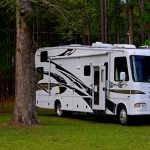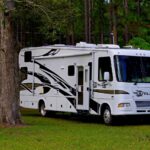Imagine waking up to a new sunrise every day, your home on wheels parked beside a serene lake or tucked under towering pines. Sounds dreamy, right? But what does it really cost to live in an RV full-time? Spoiler alert: it’s not just about fuel and campground fees. From unexpected repairs to internet bills, the expenses can surprise even seasoned road warriors. In this deep dive, we’ll unpack 12 essential cost factors that every aspiring full-time RVer needs to know before hitting the road in 2025.
Whether you’re dreaming of a cozy Winnebago or a sleek Coachmen, understanding the full financial picture will help you budget smartly and avoid nasty surprises. Ready to discover how to make your RV lifestyle both affordable and adventurous? Let’s roll!
Key Takeaways
- Full-time RV living costs range widely—expect anywhere from $1,800 to $3,800 per month depending on your rig, travel style, and location.
- Fuel, campground fees, and maintenance are the biggest expenses, but don’t overlook insurance, health coverage, and connectivity costs.
- Boondocking and RV club memberships like Good Sam and Passport America can save you hundreds on lodging.
- Choosing the right RV brand (Winnebago, Coachmen) and shopping used can significantly reduce upfront costs.
- Planning for hidden costs such as dump fees, repairs, and mail forwarding is critical to avoid budget blowouts.
👉 Shop Popular RV Brands:
- Winnebago: RVShare | Outdoorsy | Winnebago Official Website
- Coachmen: RVShare | Outdoorsy | Coachmen Official Website
Ready to master the art of full-time RV budgeting? Keep reading for our expert insights and insider tips!
Table of Contents
- ⚡️ Quick Tips and Facts About Full-Time RV Living Costs
- 🏕️ The Evolution of Full-Time RV Living: A Cost Perspective
- 1. Fuel Expenses: Navigating Gas and Diesel Costs on the Road
- 2. Finding Affordable RV Parks and Campgrounds: Lodging Costs Demystified
- 3. Grocery Shopping on Wheels: Budgeting Food Costs While Traveling
- 4. Dining Out vs. Cooking In: Eating Out Expenses for Full-Time RVers
- 5. Staying Connected: Phone Plans and Internet Options for RVers
- 6. Keeping Your Home on Wheels in Shape: RV Maintenance and Repairs
- 7. Protecting Your Investment: Understanding RV Insurance Costs
- 8. Health Coverage on the Road: Health Insurance Options for Full-Time RVers
- 9. Utilities and Miscellaneous Expenses: Power, Water, and Waste Management
- 10. Budgeting for Emergencies and Unexpected Costs on the Road
- 11. How to Save Money Living in an RV Full-Time: Expert Tips and Hacks
- 12. Comparing Full-Time RV Living Costs to Traditional Housing
- Join Our Email List for Exclusive RV Living Cost Insights
- 🎯 Conclusion: Is Full-Time RV Living Worth the Cost?
- 📚 Recommended Links for Full-Time RV Living Resources
- ❓ FAQ: Answering Your Burning Questions About RV Living Costs
- 🔗 Reference Links and Data Sources
⚡️ Quick Tips and Facts About Full-Time RV Living Costs
Living in an RV full-time can be an incredible adventure, but it’s crucial to understand the costs involved. Here are some quick tips and facts to get you started:
💡 Key Takeaways:
- Expect a wide range of costs: Full-time RV living expenses can vary greatly depending on your RV type, travel style, and personal spending habits.
- Budgeting is essential: Create a detailed budget to track your expenses and ensure you’re staying within your financial limits.
- Consider the “hidden costs”: Don’t forget to factor in unexpected expenses like RV repairs, medical emergencies, and campground fees.
- Embrace a minimalist lifestyle: Living in a smaller space often encourages a more minimalist approach, which can help you save money on possessions and storage.
- Research and compare: Explore different RV models, campgrounds, and service providers to find the best deals and options that fit your needs.
📊 Average Monthly Costs:
| Expense Category | Average Monthly Cost |
|---|---|
| RV Payment | $400 – $800 |
| Fuel | $200 – $500 |
| Campground Fees | $300 – $800 |
| Groceries | $400 – $800 |
| Utilities | $100 – $200 |
| Maintenance | $100 – $200 |
| Insurance | $100 – $200 |
| Other Expenses | $200 – $500 |
Total Average Monthly Cost: $1,800 – $3,800
Note: These are just averages, and your actual costs may be higher or lower depending on your circumstances.
💰 Tips for Saving Money:
- Buy a used RV: Used RVs can offer significant savings compared to new ones.
- Boondock or dry camp: Free camping options, like BLM land or Walmart parking lots, can help you save on campground fees.
- Join RV clubs: Organizations like Good Sam Club and Passport America offer discounts on campgrounds and other services.
- Cook more meals at home: Eating out can be expensive, so try to cook more meals in your RV to save money.
- Use a fuel card: Fuel cards can offer discounts on gas and diesel.
- 👉 Shop for insurance: Compare quotes from different RV insurance providers to find the best rates.
- Be mindful of your energy consumption: Conserve water and electricity to reduce your utility bills.
🏕️ The Evolution of Full-Time RV Living: A Cost Perspective
Full-time RV living has evolved significantly over the years, and so have the costs associated with it. In the early days of RVing, it was often seen as a more affordable way to travel and experience the open road. However, as the popularity of RVing has grown, so have the costs of RVs, campgrounds, and other related expenses.
📈 The Rise of RVing:
- Increased demand: The COVID-19 pandemic led to a surge in RV sales and rentals, as people sought alternative travel options and a sense of freedom.
- Supply chain issues: These issues have impacted the production and availability of RVs, leading to higher prices.
- Inflation: Rising inflation has affected the cost of everything from fuel to food to campground fees.
🚐 The Changing Landscape of RV Living:
- Luxury RVs: The market has seen a growing demand for luxury RVs with high-end amenities and features, which come at a premium price.
- Glamping: Glamping (glamorous camping) has become increasingly popular, with many campgrounds offering luxurious accommodations and amenities.
- Digital Nomads: The rise of remote work has led to an increase in digital nomads who are choosing to live and work full-time in RVs.
🧭 Navigating the Costs:
- Be informed: Stay up-to-date on current RV market trends and costs to make informed decisions.
- Be flexible: Consider alternative options, such as boondocking or staying in less popular campgrounds, to save money.
- Embrace a mindful approach: Focus on experiences and quality time rather than material possessions to find fulfillment in RV living.
Remember: Full-time RV living is a lifestyle choice, and the costs involved are just one aspect to consider. By understanding the factors that influence costs and making informed decisions, you can create a fulfilling and financially responsible RVing experience.
🎯 Conclusion: Is Full-Time RV Living Worth the Cost?

So, is living in an RV full-time worth the cost? After diving deep into every expense—from fuel and groceries to insurance and maintenance—our expert team at RV Brands™ can confidently say: Absolutely, yes! But with a big caveat: it depends on your lifestyle choices, travel habits, and how well you budget.
The Upside 🚐✨
- Freedom and Flexibility: You’re not tied down to a mortgage or a single location. The open road is your oyster!
- Lower Fixed Costs: Compared to traditional housing, many RVers enjoy significantly reduced monthly payments and utility bills.
- Community & Adventure: The RV lifestyle offers a unique blend of community, nature, and adventure that’s hard to beat.
The Challenges ⚠️
- Variable Expenses: Fuel, campground fees, and maintenance can fluctuate wildly depending on your travel style and rig.
- Hidden Costs: Unexpected repairs, health insurance, and internet connectivity can add up if you’re not prepared.
- Lifestyle Adjustments: Downsizing your possessions and adapting to smaller living quarters isn’t for everyone.
Final Thoughts
If you’re ready to embrace a minimalist, adventurous lifestyle and plan your budget carefully, full-time RV living can be both affordable and deeply rewarding. Remember the golden rule: plan for the unexpected, and keep your sense of humor handy! 😄
For those considering buying an RV, we recommend exploring used models from reputable brands like Winnebago and Coachmen for a balance of quality and value. And don’t forget to join clubs like Good Sam and Passport America to unlock savings on campgrounds and services.
Ready to hit the road? Keep your budget flexible, your tank full, and your spirit adventurous!
📚 Recommended Links for Full-Time RV Living Resources
CHECK PRICE on Popular RV Brands:
- Winnebago: RVShare | Outdoorsy | Winnebago Official Website
- Coachmen: RVShare | Outdoorsy | Coachmen Official Website
Books to Deepen Your RV Knowledge:
- The RV Handbook: Essential How-To Guide for the RV Owner by Dave Solberg — Amazon
- Living the RV Life: Your Ultimate Guide to Life on the Road by Marc and Julie Bennett — Amazon
- Full-Time Freedom: How to Live in an RV and Travel Full-Time by Cody and Katie — Amazon
RV Memberships & Discounts:
❓ FAQ: Answering Your Burning Questions About RV Living Costs

What are the average monthly costs of living in an RV full-time?
Answer: On average, full-time RVers spend between $1,800 and $3,800 per month covering all essentials like RV payments, fuel, campground fees, groceries, utilities, maintenance, and insurance. This range depends heavily on your rig type, travel frequency, and lifestyle choices. For example, boondocking (free camping) can drastically reduce lodging costs, while frequent travel increases fuel expenses. According to Heath & Alyssa, a typical monthly budget might look like $600 for the rig, $250 for gas, $750 for lodging, $600 for groceries, and $250 for phone/internet, totaling around $3,050.
Read more about “29 Irresistible Reasons to Live in an RV in 2025 🚐”
How much does insurance cost for a full-time RV lifestyle, and what factors affect the rates?
Answer: RV insurance typically costs between $700 and $2,000 annually, or about $60 to $170 per month. Factors influencing rates include:
- Type and value of your RV: Luxury diesel motorhomes cost more to insure than older or smaller rigs.
- Usage: Full-time living vs. occasional travel affects premiums.
- Driving history and location: Your driving record and where you register your RV matter.
- Coverage level: Comprehensive plans with roadside assistance cost more but offer better protection.
Providers like Good Sam offer competitive rates and roadside assistance packages, which many full-timers find valuable. Always shop around and compare quotes.
What are the cheapest states to live in an RV full-time, in terms of camping and parking costs?
Answer: Some of the most affordable states for full-time RV living include:
- Arizona: Abundant BLM land for free boondocking and mild winters.
- New Mexico: Offers extensive public lands and low-cost campgrounds.
- Texas: Large state with many free or low-cost camping options, plus no state income tax.
- Florida: While some areas are pricey, many state parks and public lands offer reasonable rates.
Avoiding high-cost states like California, especially for extended travel, can save you hundreds monthly on fuel and campground fees. Use resources like Boondockers Welcome and Harvest Hosts to find free or low-cost stays.
What are the hidden costs of full-time RV living that beginners should be aware of when creating a budget?
Answer: Hidden costs can sneak up on you if you’re not prepared. Watch out for:
- Maintenance and repairs: Unexpected issues like fuel pump replacements or generator servicing can cost hundreds to thousands. Budget at least $100/month for upkeep.
- Health insurance: Medical coverage on the road can be pricey, often $200-$300/month depending on your plan.
- Internet and phone: Reliable connectivity is essential, especially for remote work, and can run $100-$300/month.
- Dump fees and utilities: Some campgrounds charge for sewage dumping or water refills.
- Tolls and parking fees: Toll roads and overnight parking fees add up, especially in the Northeast and California.
- Mail forwarding and storage: If you don’t have a permanent address, mail services and storage units can be additional expenses.
Planning for these “extras” will keep your budget realistic and avoid nasty surprises.
🔗 Reference Links and Data Sources
- Heath & Alyssa, Cost to Live in an RV Full-Time — https://heathandalyssa.com/cost-to-live-in-an-rv/
- Today Is Someday, Annual Cost of Full-Time RV Living — https://todayissomeday.net/blog/annual-cost
- EcoFlow Blog, Full-Time RV Living in the US: How Much Does It Really Cost? — https://blog.ecoflow.com/us/cost-of-full-time-rv-living/
- Good Sam Club — https://www.goodsam.com
- Passport America — https://passportamerica.com
- Harvest Hosts — https://harvesthosts.com
- RVShare (Winnebago Search) — https://rvshare.com/rv/winnebago
- Coachmen Official Website — https://coachmenrv.com
For more insights on the joys and challenges of full-time RV living, check out our detailed guide on 29 Irresistible Reasons to Live in an RV in 2025 🚐. Happy trails!





